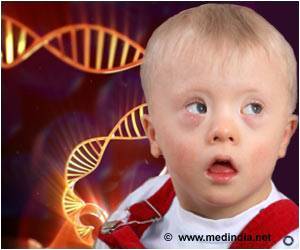A submicroscopic aberration in a particular region of human chromosome 1q21.1 appears to be associated with a variety of developmental disorders in children
A submicroscopic aberration in a particular region of human chromosome 1q21.1 appears to be associated with a variety of developmental disorders in children, researchers have revealed.
The aberration can manifest itself as unexplained mild or moderate mental retardation, growth retardation, learning disabilities, seizures, autism, heart defects, other congenital abnormalities, cataracts, small head size, unusual facial features, hand deformities, or skeletal problems. Some people who have the aberration are only slightly affected or apparently unaffected, others are more seriously impaired.The multinational research was led by Dr. Heather C. Mefford, acting assistant professor of pediatrics at the University of Washington, and Dr. Andrew J. Sharp. Marie Curie Fellow in the Department of Genetic Medicine and Development, University of Geneva, Switzerland. Mefford practices medical genetics at Children's Hospital and Regional Medical Center in Seattle and the UW Medical Center Medical Genetics Clinic.
The results will be published in the Sept. 11 New England Journal of Medicine in an article titled, "Recurrent Rearrangements of Chromosome 1q21.1 and Variable Pediatric Phenotypes." The results are discussed in an accompanying editorial by David H. Ledbetter of Emory University in Atlanta.
Deletions and duplications of large sections of the human genome have long been known to cause disease or make a person susceptible to disease. Recent technological advances, called microarrays, are enabling scientists to test large numbers of people to determine the presence or absence of submicroscopic imbalances in small sections of their chromosomes.
Using these new advances, the researchers checked for the presence of microdeletions and microduplications in a specific region of chromosome 1q21.1 in groups of patients with unexplained mental retardation, autism, or congenital abnormalities, and compared their findings with similar testing of a group from the general population. In these 4,737 controls from the general population, no microdeletions were found, and only one had duplication of the entire region.
The authors explained that the genomic structure of 1q21.1 is extremely complex. There are still 15 assembly gaps, or 700 kb of missing sequence in 1q21.1, in the most recent map of the human genome.
Studies by other groups of researchers have also found a connection between 1q21.1 deletions and schizophrenia in some people, and parts missing in the reproductive tract in other people. These results, the authors of the Sept. 11 New England Journal of Medicine article noted, confirm the association of 1q21.1 rearrangements with a broad spectrum of disorders, and also further dispel the notion that such rearrangements will necessarily follow a "one-gene, one-disease" model.
This study, the authors said, adds 1q21.1 as a chromosomal locus to the growing list of structural variants that should be included in genetic screening panels for people with developmental delays or neuropsychiatric diagnoses.
Source-Newswise
RAS
 MEDINDIA
MEDINDIA




 Email
Email





